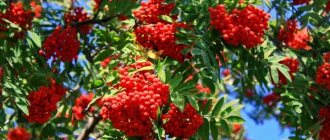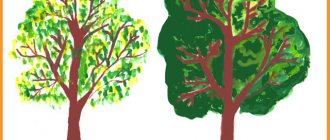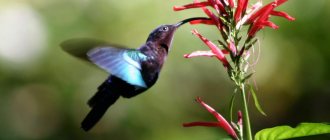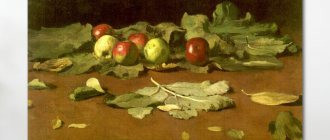- Reports and messages
- Plants
- Spruce
Spruce belongs to the pine family.
This is an evergreen tree, a symbol of the New Year. Spruce can grow up to fifty meters in height and live up to three hundred years. In the USA there is a spruce tree that is eight hundred and fifty-two years old. There are about forty-five varieties of tall spruce trees. Of these, the following can be noted: Eastern European or ordinary, Siberian, Oriental, Korean, Ayak, Tien Shan, Glen spruce, Canadian, red, Serbian, blue.
Low spruces are called dwarf. Dwarf spruces have found wide application in the field of landscape design and are often used in home and interior decoration. There are the following types of dwarf spruce trees: Push spruce, Nidiformis spruce, Nana spruce, Bialobok spruce.
The distribution area of spruce is very large. The common spruce has the largest distribution area: Western Europe, Russia and the Urals. Siberian and Ayan spruce grows in Siberia, and eastern spruce grows in the Caucasus. There are varieties of spruce that grow in certain climates: for example, only on the Kuril Islands, southern Sakhalin and the island of Hokkaido.
Spruce reproduces with the help of heterosexual cones. When the seeds ripen, the cone falls to the ground and is carried away by the wind, sometimes very far. Spruce begins to reproduce after fifteen years of growth.
Spruce is not only an ornamental plant, it is widely used in various fields. Spruce bark, wood, pine needles and cones are used.
Spruce wood is very “musical” and has the ability to “hold” sound. The speed of sound propagation in spruce is fifteen times greater than the propagation of sound in air. Previously, in Rus' they made harps from spruce, but now they make soundboards for cellos, violins and guitars. To do this, choose a tree without curls and knots. Since houses were previously built from spruce, restorers are looking for pieces of spruce in the ruins of old houses that will be used in restoration: it is believed that such spruce has acquired even greater musicality with age. They tried to replace the spruce with another tree, but they did not find a second such “musical” tree.
The second major area of spruce is wood chemical production. Cardboard, paper, cellulose are made from it, and turpentine is obtained. Tannins are obtained from the bark, which are used in industry for tanning leather and in medicine.
Essential fractions and volatile oils are isolated from the needles, which are used in the perfume industry and medicine.
Spruce is widely used in ornamental gardening and park construction. Spruce trees are often planted along roads for protection from the wind. Nuts from the cones serve as food for birds and animals.
In many countries, spruce is decorated for the New Year. In America, the Christmas tree is decorated long before Christmas. They decorate mainly with edible decorations: tangerines, sweets and red and white candies in honor of Jesus Christ.
In Germany, Christmas trees glow and shimmer. They are decorated with balls, garlands, and Santa Claus figurines.
In Finland, trees are protected, so they prefer to decorate artificial Christmas trees with homemade decorations.
In many countries, for the New Year they decorate not a Christmas tree, but other trees: in China - a tangerine or orange tree, in Mexico - a palm tree, in Africa - a baobab tree. Often in Asian countries they dress up not a tree, but a rake in order to “rakes” more wealth in the new year.
Description
The Christmas tree is a slender tree that can grow up to 35 meters high. During the first 10 years it grows very slowly - a few cm per year, then the growth rate increases, but after 100-120 years it slows down again. It has a pyramidal (triangular) crown with a sharp tip. The branches are densely located throughout the trunk. It is often difficult to see behind the spruce feet.
In a young tree, the bark is smooth, gray-brown in color; in an old tree, the bark becomes gray and peels off in thin plates. The needles are dark green and shiny, sharp and prickly. The needles are much shorter than those of pine, up to 3 cm long.
They stay firmly on the branches for 7-10 years. But in urban conditions, with heavy smoke in the air, the lifespan of needles is greatly reduced: they fall off after only 3 years.
The spruce root system is located close to the surface, so strong winds can knock down the tree.
Spruce is a long-liver, it lives 250-300 years.
image of Eli
Since childhood, at Christmas and New Year, people have become accustomed to smelling fir branches.
Mixing with the smell of tangerines, this fragrant pine aroma was a harbinger of a miracle, gifts, new experiences and the New Year. For many centuries, Spruce has personified the symbol of a new cycle. In ancient times, remaining evergreen, Spruce was an allegory of eternal youth and immortality, longevity and fidelity.
For the same reasons, the Spruce “spruce branches” were and remain in many villages a sign of a bygone life. During the funeral procession, “spruce branches” are thrown at the feet, saying goodbye to the departed. Their age has ended, but has passed into eternity.
In Scandinavia, spruce was used for ritual bonfires. The resinous firewood gave the fire unique strength.
Where does it grow
It grows throughout the Northern Hemisphere. It can be found in North America, Central and Northern Europe. It is widespread in Russia: in Siberia, the Urals, the Far East, the Caucasus, and in the steppe zone. Also grows in China and Japan.
50 types of in total . The most common: Siberian, European, Caucasian, Canadian, white, red, black.
The Christmas tree is the basis of the taiga. It grows in mixed forests, coexisting well with larch, pine, Siberian cedar, fir, oak, linden, birch, aspen, and hazel. It also forms pure spruce forests, which have a number of features:
- It's damp and dark here;
- the soil is completely covered with moss;
- under the spruce paws grow dense thickets of blueberries, lingonberries, wood sorrel, ferns, and cuckoo flax.
Medicinal properties of Spruce
Fir cones, pine needles and resin are used for medicinal purposes.
The needles contain bactericidal substances, amino acids, chlorophyll, vitamins and phytoncides. Spruce needles are rich in vitamin C, the concentration of which increases in winter, therefore, since ancient times, pine “tea” has been an excellent remedy for scurvy and at the same time strengthened the entire body.
Daily consumption of 3–4 spruce needles for a month can restore immunity and increase resistance to a number of viral diseases.
Several spruce branches placed in a vase in a room can kill harmful bacteria in the room, leaving a pleasant aroma in the air.
Fir cones are rich in tannins and essential oils. They also contain copper, manganese, aluminum, and iron.
Essential oils are used in the fight against acute respiratory infections and diseases of the upper respiratory tract.
Syrup from the buds of Spruce is prescribed for microinfarctions.
A decoction of pine needles is used by inhalation to treat sore throat and sinusitis.
Spruce resin or resin has antiseptic properties and can be used in ointments to heal wounds and ulcers.
Growing conditions and reproduction
For a spruce to grow well, it needs the following conditions:
- Shadow. This tree does not really like the sun; young trees often get sunburned in open areas.
- Sufficient hydration. The Christmas tree does not tolerate drought well.
- Temperate climate. The tree is cold-resistant, not afraid of frost, but it does not grow well in the southern regions, where summers are too hot and long,
- The soil should not be too dense, but moderately fertile.
Spruce is a monoecious plant. This means that male spikelets and female cones grow on the same tree. Propagated by seeds, the germination rate of which is very good. The cones open in late November - early December, the seeds fall out, are picked up by the wind and carried far around the surrounding area.
In early spring, the seed awakens and begins to grow. The main condition for the sprouts to take root and begin to develop well is a warm spring, because they die during spring frosts.
Conclusion
It is impossible to remain indifferent to the strict symmetrical silhouettes and exquisite shades of blue spruce trees. That is why these noble conifers are often found in landscape design projects. They harmonize perfectly with other plants, look good at any stage of growth and emit a pleasant, calm energy. By choosing popular varieties of blue spruce, you will surely decorate the landscape and create a green corner that you will love with all your heart.
You can also see all our live Christmas trees for sale.
Rate this article
(Votes: 21, Rating: 5.43)
Use in the national economy
Spruce plantations can often be seen in sanatoriums. Because their needles release phytoncides that clean and disinfect the air. Also, spruce often becomes the basis of landscapes in personal plots.
High-quality musical instruments are made from this wood. Soft wood is used to make paper, rayon, and smokeless gunpowder. Resin, tar, rosin, and turpentine are obtained.
Fir cones are widely used in folk medicine. Healers believe that a Christmas tree is a donor tree; if you lean against it and stand there for a few minutes, it will give a person energy and strength.
the forest guest for the New Year.
How much joy it brings, filling the house with a special forest smell and pleasing the eye with its beauty!
If this message was useful to you, I would be glad to see you in the VKontakte group. Also, thank you if you click on one of the “like” buttons:
Popular message topics
- Bedbugs
- belong to the phylum arthropods, representatives of the class insects, from the order Hemiptera, one of the most numerous insects, about 40,000 thousand species, more than 50 families. - Angiosperms
The order Angiosperms unites higher plants, the seeds of which ripen inside the fruit (and not cones, as in gymnosperms). There are an absolute majority of such plants on the planet: scientists identify about 250 thousand species. This is the most numerous - Metal alloys
Long ago, people noticed, speaking about biology, for example, that if you combine two organisms, the third will surpass its parents. It turns out that the same principle works in chemistry, so the history of the appearance of alloys can be considered straightforward.
Yew
The leaves of this species are hard, linear or lanceolate, with narrow or wide needles. For the most part, trees remain green all year round, but there are, although very rarely, species that lose leaves in winter.
Interesting fact : yew needles are dangerous for animals, as they cause poisoning.
Yew berry
Yew berry
A very elegant evergreen plant, sometimes reaching 40 m in height, has healing properties. At the same time, it is poisonous. It grows slowly, but its life expectancy is high - several thousand years. A lush, dense bush in shape resembles a cylinder or pyramid. The bark is smooth, red-gray. Flat dark green needles 20-35 mm long are arranged in a spiral. The strong branched root allows the yew to grow in any type of soil. It reproduces by seeds, which are spread by birds eating the berries of the bush.
Torreya
Torrey
The genus of the yew family is named after the American flora researcher John Torrey. It is a small tree, usually 5-20 m in height. The spiral-shaped needles are rigid, with pointed ends. The plant can be either monoecious or dioecious. Female cones mature in a year and a half. The only large seed looks like a nut.
The needles, stems, and cones emit a very unpleasant aroma. The range of torrea is East Asia and North America.
Deciduous trees
Let's get acquainted with the main types of deciduous trees that are found in cities, forests and parks of our country.
Birch
The most beloved tree in Russia is often called the “tree of life”, “Russian beauty”, “bride”. Birch is easily recognized by its trunk, covered with almost white bark - birch bark. The leaves of the birch are not large, the crown is not too thick, it allows light to pass through, so it is rarely dark in the birch forest.
This tree grows throughout Russia - and not only. Due to its unpretentiousness, birch is found everywhere in the Northern Hemisphere and even beyond the Arctic Circle. Dwarf birch grows in the tundra - less than 1 meter tall.
An ordinary birch grows up to 15 meters and even higher - up to 30. The tree lives for about 100 years.
Birch flowers are called “catkins”; they look more like soft flexible hanging cones than flowers.
Birch is one of the most useful trees growing in our climate. Its leaves contain many healing substances, so they are used both in the form of decoctions and for preparing infusions that help with various diseases and as a general tonic. Birch sap is tasty and healthy. Bath brooms are made from birch branches and leaves, which promote the healing of wounds and abrasions. And even the smell of birch is believed to “heal from the evil eye and bad mood.”
Since ancient times, the top layer of birch bark - birch bark - has been widely used. Since it is resistant to dampness, it was used in construction; and in everyday life they were used to make household utensils. “Birch bark letters”—records made on bark—have survived to this day. They are of great interest primarily for historians involved in the study of Ancient Rus'.
Linden
The ancient Slavs said that the linden tree is “the mother tree: it feeds, puts on shoes, and heals.” But linden grows not only in Russia; it can be found in many European countries, even in the north (Norway, Finland). Although most of all linden loves a warm and fairly humid climate.
This tree can be found both in gardens and parks, as well as in forests and fields.
It is easy to distinguish - by its reddish branches and leaves, which have a characteristic round shape with small teeth. The crown of the linden tree is not as delicate as that of the birch tree; it creates a thick, cool shadow. Linden can reach 30 meters in height.
Linden shows itself most clearly during flowering. At the end of June - July, the entire tree is covered with beautiful light yellow inflorescences, emitting a strong honey aroma. In addition to their beautiful appearance, linden flowers have good disinfectant properties.
But the young plant does not bloom immediately. A linden tree planted artificially begins to bloom only after 30 years; under natural conditions - 10 years earlier. In general, linden lives for quite a long time, up to 400 years, but there are known cases of “long-living trees” that are 1000 years old or even more.
Linden seeds are small, similar to peas, which are collected in several pieces on one stalk equipped with a light “wing”. These wings help the seeds scatter, and the seeds themselves serve as food for birds.
The Slavs have long used linden in a variety of ways: cutlery and dishes were made from the wood, bast shoes were woven from the bark, and linden blossom was used to treat many diseases.
Linden is one of the most useful honey plants; honey is called "Lipets". And the tree itself got its name from its sticky buds and leaves.
Oak
“Oak-giant”, “oak-giant”. It is no coincidence that people and literature associate this tree with strength and power. The oak looks the part: a large, mighty tree with an immense trunk and a rich crown. The tree reaches 40 meters, but does not grow throughout its life: at the age of 100-200 years, growth in height stops. A slight increase in width continues throughout the life of the tree, but it lives for a long time, sometimes up to 2 thousand years!
Oak leaves have a beautiful intricate shape with rounded teeth. The bark is strong and thick, dark in color.
The oak is one of the last to leaf out in the forest - sometimes closer to the beginning of summer. And it blooms immediately. Its flowers are located on long hanging “earrings”.
All children love and know oak fruits. These are acorns - cute oblong nuts hanging on their caps. They can be eaten.
Acorn coffee is a fairly common drink in the world. And in their raw form, pigs and wild boars enjoy eating acorns.
Oak bark, which contains tannins and natural antiseptics, is widely used in medicine.
Oak wood is one of the most sought after and valuable in the world.
Previously, oak was also used in ink production: from the so-called “galls” or “ink nuts” (balls that form on oak leaves due to the interaction of tannins with substances secreted by special larvae living on the tree) paint was extracted, which was included in composition of permanent ink. In Pushkin's time they wrote with exactly this ink.
Maple
When you think of this tree, the first thing that comes to mind is its leaves. They are actually very beautiful - and absolutely original, with five sharp, curly “fingers”. Maple leaves are especially picturesque in the fall, when they turn all shades of yellow and red. And maple seeds look like dragonflies with their transparent, light wings.
The tree itself is quite large, it can grow up to 30 meters in height and up to one and a half meters in diameter. In general, maple grows very quickly.
There are more than 100 species of maple in the world. Norway Maple is the most common species in our country. And in Canada, the maple tree is a national favorite; the leaf design even adorns the national flag. By the way, the Canadian maple lives much longer than “ours”: up to 500 years, whereas in our forests it lives only up to 200.
Maple loves illuminated areas, so there are practically no pure maple forests - the tree grows mainly on the edges. The maple tree blooms in May with medium-sized yellow-green flowers.
Maple syrup is very popular in Canada and North America. It is obtained from tree sap. But there is no point in trying to get it from our maples - it can only be obtained from a special variety. Although our maples also produce juice, it is not as tasty, but it is used in medicine to strengthen the immune system and treat nerves. Maple leaves have antiseptic properties.
Maple is famous for its particularly durable wood, which, among other things, has special acoustic properties, which is why it is used in the manufacture of musical instruments.
Poplar
This tree is a fast-growing tree, therefore it is widely used for landscaping cities.
Everyone is well aware of this slender, tall tree with a thick silvery crown. Poplar bark is also grayish, often covered with cracks.
Although poplar is considered a rather whimsical tree, it grows almost everywhere - in the middle zone, in Siberia, in America, and even in Africa. But poplars do not live too long - the maximum age is about 150 years. Although, like other plants, among poplars there are long-livers, reaching 400 years of age.
Poplar flowering begins quite early, in April or May (depending on the region). The entire tree is covered with long gray-green catkins, which are considered very honey-bearing.
But the most interesting thing comes later, when the poplar fades. Some trees, the so-called females (poplars also have male ones), have flowers that turn into fluffy, cotton-like clusters that scatter in different directions and literally cover everything around with a white carpet. This is poplar fluff.
A beautiful sight, but some people suffer greatly from the fluff - it is believed to provoke allergic reactions. Therefore, now many cities are gradually getting rid of “downy” poplars. According to many scientists, it is completely in vain. After all, poplar is the leader among all trees in its ability to absorb harmful substances and release oxygen. This is precisely the main benefit of poplar. Although in medicine, decoctions from various parts of the plant are also used: bark, seeds and buds.
Poplar wood is not considered very durable, but is widely used for making matches and paper.
Willow
A popular and widespread tree in our country. Most often, when people talk about willow, they mean weeping willow - a tree with long flexible branches inclined to the ground. But in fact, there are many varieties of willow - more than 500 species, growing almost everywhere in the Northern Hemisphere. Rakita, willow, vine - these are all willow trees.
Willow is unpretentious, but most often grows in well-moistened soil.
Among the varieties of willow there are plants with very different properties: tall trees, more than 30 meters, and shrubs and even dwarf willows, not exceeding 3 centimeters in height.
Almost all willows have thin, flexible and brittle branches, but their colors can vary from red to dark green. The buds are also of different colors and shapes.
Many people know that such a popular plant as pussy willow is a type of willow. But the cute fluffy gray balls on the branches are not buds, as one might think, but flowers.
In general, willow is an early plant; buds appear on it in winter, so for many peoples it is a symbol of spring and the awakening of nature.
Interestingly, the weeping willow got its name not only because of its hanging branches: these trees often grow near bodies of water and receive too much moisture through the roots, which it leaves through the leaves; and then it seems that the tree is literally “crying.”
Willow is widely used in folk medicine: its bark contains many unique substances, for example, tannin. The anti-malaria medicine quinine is also obtained from willow.
Wicker furniture and baskets are traditionally made from willow vines.
Aspen
The name of this tree means “trembling man” in Latin. And indeed: even with the slightest breeze, the leaves on the tree begin to move, and it seems that the whole plant is trembling. This is explained by the fact that the leaves are held on the branch by a long and thin stalk, which reacts to any air fluctuations.
In fact, aspen is not such a “delicate” tree. On the contrary, it has such long and powerful roots that some aspen trees are able to survive a fire: even if the trunk and crown are burned, the root system can produce new shoots.
The aspen has a long light trunk. The tree can grow up to 35 meters in height, and quite quickly. On average, a tree lives 100 years.
An interesting property of aspen is that a blue tint appears on the log house. This occurs due to the contact of tannins contained in the wood with the metal of the cutting tool - but it all looks quite ominous, especially against the background of the white trunk. Perhaps this is why aspen does not have a very good “reputation”: in ancient times, people believed that evil spirits lived in aspen groves.
Of course this is not true. Aspen is a useful tree: its wood is considered especially valuable, it is soft, pliable and easily stained, and the bark contains many useful substances, including antibiotics, glycerin, and esters. The first aspirin was obtained from aspen bark.
In addition, the tree looks aesthetically pleasing, it has a slender trunk, neat leaves that look like coins with teeth, and a dense crown. Aspen blooms in April, and the male and female plants have catkins of different colors: males are reddish, females are green.
Chestnut
This tree is especially loved by children for its smooth brown fruits enclosed in a green shell with thorns. At the beginning of autumn they fall, break with a crunch and scatter the ground under the trees.
The plant itself is very decorative: it has a wide dome-shaped crown, carved “finger” leaves with long cuttings, and the chestnut blooms with beautiful inflorescences in the form of candles. Some species have white flowers, while others have reddish flowers.
Due to its attractiveness and undemanding nature in terms of soil and air pollution, chestnut is widely used in cities for the purpose of landscaping streets, squares and parks.
They also like to plant chestnuts in private gardens, but in a small area the roots of the tree can spread up to 6 meters in different directions and interfere with other plants.
This tree is known not only for its beauty. Some chestnut species have edible fruits. And even if they cannot be eaten - such as the horse chestnut, common in Russia - they are widely used in pharmacology and folk medicine.
Edible chestnuts do not grow in Russia - the birthplace of these trees is in Asia, the USA, and the Mediterranean. They are larger than ours (they grow up to 50 meters).
The chestnut tree lives for 150–200 years, but cases have been recorded where individual trees lived to be 2–3 thousand years old.
Ash
The tree, whose height reaches 30 meters, transmits sunlight well, despite the lush crown. This is due to the special shape of ash leaves - they are long and narrow and are held on sparse branches. It is believed that the name of the tree comes precisely from this property - it is always light and clear under it. In addition, the tree emits a pleasant, fresh aroma thanks to the coumarin contained in the bark.
More than 70 varieties of ash are known, growing all over the world: in Europe, North America, North Africa, and the Far East. Common ash has become widespread in Russia. It grows in gardens and parks, but is less common in forests. More often you can see this handsome handsome man in the middle of the field.
Ash blooms in April-May and is considered a good honey plant. The fruits appear in the fall, but can remain on the branches until spring - they are very helpful for birds in winter, since they contain a large amount of nutrients.
The wood of this tree is of the greatest value: it is durable, beautiful in color and has an interesting texture. However, the leaves, fruits, and bark of the tree are also used for medicinal purposes.
Cherry
There are quite a lot of varieties of this plant - more than 130. The cultivated varieties of cherries are well known, but there are also wild species. They are found in the Far East, China, Japan, and the Himalayas. There is also steppe wild cherry, which can be found in Russia. These trees are significantly lower than their cultivated “brothers”.
The Black Sea coast is considered the birthplace of cherries.
Cherry is usually a short tree, no more than 10 meters, trunk diameter is about 40 centimeters. Cherry has a powerful root system and not too dense crown
From an aesthetic point of view, cherries are most attractive in April-May, when they bloom. This tree blooms profusely with beautiful white flowers.
But cherries have gained universal love thanks to their fruits - fragrant, dark red, sweet and sour berries. They appear in June and are not only tasty, but also extremely healthy: they contain vitamins, microelements, and metals.
In the furniture industry, cherry wood is used in the manufacture of expensive furniture.
Interestingly, garden cherries are scientifically called “sour cherries,” regardless of their taste. And sweet cherries (which are a type of cherry) are officially called “bird cherries.”
Garden cherries live for about 100 years, wild cherries - no more than 20.
Japan is very proud of its cherry tree - sakura, which blooms with pink flowers. This type of cherry is not edible, but is so beautiful that in Japan there is a special holiday - Hanami - “sakura viewing”. This event has the status of a national holiday for the Japanese. Moreover, it is customary to admire the blossoms not only during the day, but also in the evenings - at this time the trees are illuminated in a special way.
Geography courses for children 6-13 years old
In the online course “Amazing Planet” we introduce children to the most important places in Russia and the world in a fun format through games, stories and riddles
find out more
Taxonomy [edit | edit code ]
Picea
A.Dietr. Fl. Berlin 1(2): 794. 1824.
syn. Veitchia Lindl. The Gardeners' Chronicle & Agricultural Gazette 1861: 265. nom. rej. against Veitchia H.Wendl., 1868 Flora Vitiensis 270. 1868. nom. cons.
Rod El
is part of the Pine family (
Pinaceae
) of the order Pine (
Pinales
) [9].
| Types [edit | edit code ] Genus Spruce , according to the Royal Botanic Gardens, Kew, includes 37 primary species and 4 hybridogenic ones [10] [11]: | ||||||










